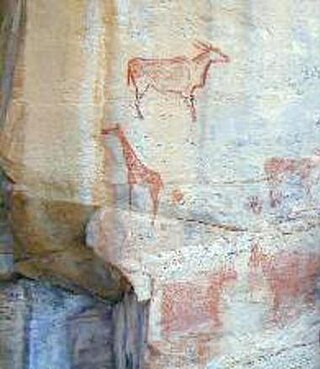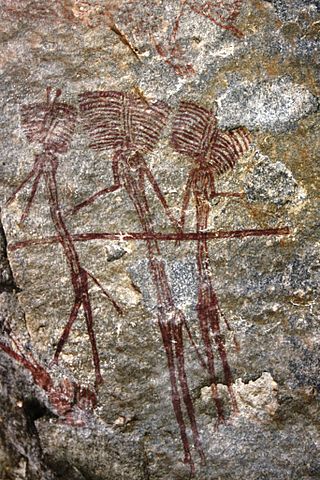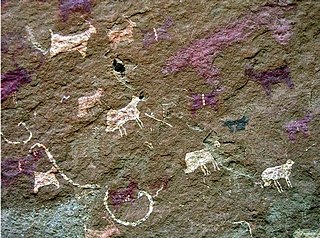
In archaeology, cave paintings are a type of parietal art, found on the wall or ceilings of caves. The term usually implies prehistoric origin. These paintings were often created by Homo sapiens, but also Denisovans and Neanderthals; other species in the same Homo genus. Discussion around prehistoric art is important in understanding the history of the Homo sapiens species and how Homo sapiens have come to have unique abstract thoughts. Some point to these prehistoric paintings as possible examples of creativity, spirituality, and sentimental thinking in prehistoric humans.

The Bhimbetka rock shelters are an archaeological site in central India that spans the Paleolithic and Mesolithic periods, as well as the historic period. It exhibits the earliest traces of human life in India and evidence of the Stone Age starting at the site in Acheulian times. It is located in the Raisen District in the Indian state of Madhya Pradesh, about 45 kilometres (28 mi) south-east of Bhopal. It is a UNESCO World Heritage Site that consists of seven hills and over 750 rock shelters distributed over 10 km (6.2 mi). At least some of the shelters were inhabited more than 100,000 years ago.

Chinguetti is a ksar and a medieval trading center in northern Mauritania, located on the Adrar Plateau east of Atar. Chinguetti had a population of 4,800 as of 2013.

The Adrar is a highland natural and historical region of the Sahara Desert in northern Mauritania. The Adrar Region, an administrative division of Mauritania, is named after the traditional region. It is sometimes called Adrar Tamar to distinguish it from other areas called Adrar in the Sahara.

The Ennedi Plateau is located in the northeast of Chad, in the regions of Ennedi-Ouest and Ennedi-Est. It is considered a part of the group of mountains known as the Ennedi Massif found in Chad, which is one of the nine countries that make up the Sahelian belt that spans the Atlantic Ocean to Sudan. The Ennedi is a sandstone bulwark in the middle of the Sahara, which was formed by erosion from wind and temperature. Many people occupied this area, such as hunters-gatherers and pastoralists. The Ennedi area is also known for its large collection of rock art depicting mainly cattle, as these animals had the greatest financial, environmental, and cultural impact. This art dates back nearly 7,000 years ago. Today, two semi-nomadic groups, mainly Muslim, live in the Ennedi during the rainy months and pass through the area during the dry season. They rely on their herds of camels, donkeys, sheep, and goats to survive.

The Tsodilo Hills are a UNESCO World Heritage Site (WHS), consisting of rock art, rock shelters, depressions, and caves in Botswana, Southern Africa. It gained its WHS listing in 2001 because of its unique religious and spiritual significance to local peoples, as well as its unique record of human settlement over many millennia. UNESCO estimates there are over 4500 rock paintings at the site. The site consists of a few main hills known as the Child Hill, Female Hill, and Male Hill.

Laas Geel, also spelled Laas Gaal, are cave formations on the rural outskirts of Hargeisa, Somaliland, situated in the Maroodi Jeex region of the country. They contain some of the earliest known cave paintings of domesticated African aurochs in the Horn of Africa. Laas Geel's rock art is estimated to date to circa 3,500-2,500 BCE.

The Kondoa Rock-Art Sites or Kondoa Irangi Rock Paintings are a series of ancient paintings on rockshelter walls in central Tanzania. The Kondoa region was declared a UNESCO World Heritage Site in 2006 because of its impressive collection of rock art. These sites were named national monuments in 1937 by the Tanzania Antiquities Department. The paintings are located approximately nine kilometres east of the main highway (T5) from Dodoma to Babati, about 20 km north of Kondoa town, in Kondoa District of Dodoma Region, Tanzania. The boundaries of the site are marked by concrete posts. The site is a registered National Historic Sites of Tanzania.

Amojjar Pass is a mountain pass in the Adrar Plateau in the centre of Adrar, near Atar, Mauritania. The pink-brown sandstone of the pass was worn away by repeated cycles of extreme dryness interrupted by torrential rain. The bases of the steep valley walls are covered in scree, loosed by the erosion of the rainfall. There is little plant life in the pass. Acacias are a notable exception, as they are resistant to drought.

The Nyero rock paintings are located in eastern Uganda in Kumi District, 8 km (5.0 mi) west of Kumi town, about 250 km (155.3 mi) from the capital city Kampala. The Nyero rock paintings are among the most important rock art in Uganda.

The group of over 700 sites of prehistoric Rock art of the Iberian Mediterranean Basin, also known as Levantine art, were collectively declared a World Heritage Site by UNESCO in 1998. The sites are in the eastern part of Spain and contain rock art dating to the Upper Paleolithic or Mesolithic periods of the Stone Age. The art consists of small painted figures of humans and animals, which are the most advanced and widespread surviving from this period, certainly in Europe, and arguably in the world, at least in the earlier works. It is notable for the number of places included, the largest concentration of such art in Europe. Its name refers to the Mediterranean Basin; however, while some sites are located near the sea, many of them are inland in Aragon and Castilla–La Mancha; it is also often referred to as Levantine Art.

The history of cave paintings in India or rock art range from drawings and paintings from prehistoric times, beginning in the caves of Central India, typified by those at the Bhimbetka rock shelters from around 10,000 BP, to elaborate frescoes at sites such as the rock-cut artificial caves at Ajanta and Ellora, extending as late as 6th–10th century CE.

The Cantabrian caves' unique location make them an ideal place to observe the settlements of early humans thousands of years ago. The magnificent art in the caves includes figures of various animals of the time such as bison, horses, goats, deer, cattle, hands and other paintings. Archaeologists have found remains of animals such as bears, the remains of arrows and other material indicating a human presence; these artifacts are now found mostly in the Regional Museum of Prehistory and Archaeology of Cantabria.

The San, or Bushmen, are indigenous people in Southern Africa particularly in what is now South Africa and Botswana. Their ancient rock paintings and carvings are found in caves and on rock shelters. The artwork depicts non-human beings, hunters, and half-human half-animal hybrids. The half-human hybrids are believed to be medicine men or healers involved in a healing dance. Gall writes, "The Laurens van der Post panel at Tsodilo is one of the most famous rock paintings." High on this rock face in Botswana is the image of a "magnificent red eland bull" painted, according to Van der Post, "only as a Bushman who had a deep identification with the eland could have painted him." Also on this rock face is a female giraffe that is motionless, as if alarmed by a predator. Several other images of animals are depicted there, along with the flesh blood-red handprints that are the signature of the unknown artist. The Drakensberg and Lesotho are particularly well known for their San rock art. Tsodilo was recognised as a UNESCO World Heritage Site in 2001; not all the art covered by this is by San people or their ancestors.

Dhambalin is an archaeological site in the central Sahil province of Somaliland. The sandstone rock shelter contains rock art depicting various animals such as horned cattle and goats, as well as giraffes, an animal no longer found in the country. The site also features the earliest known pictures of sheep in Somaliland. Discovered in autumn 2007, residents of Beenyo Dhaadheer reported the rock art to the Somali archaeologist Sada Mire, Director of the Department of Archaeology within the Ministry of Tourism and Culture of Somaliland.

The Tadrart Rouge or Southern Tadrart or Algerian Tadrart or Meridional Tadrart is a mountain range in southeastern Algeria, part of the Algerian Desert. The area has a rich array of rock art.
Within the African nation of Uganda there is rock art that "sits within a broad geometric rock art belt straddling East and Central Africa." More specifically, "In Uganda, rock art is mostly concentrated in eastern part of the country, especially in the districts of Kumi, Pallisa and Kaberamaido." The rock art has a few aspects that make it unique. Most of it is geometric art with circular, rectangular, sausage, dot and lines making up the basic shapes. These shapes occur repeatedly throughout the country. Some shapes do occur more frequently than others. Catherine Namono notes that "concentric circles are the most commonly painted shapes in the rock art of Uganda." There are also concentric circles with rays coming out of them, possibly representing the sun. Red was the most common color along with white, or both creating a bi-chrome pigment.
Iheren and Tahilahi are rock painting shelters at the Tadjelahine sandstone plateau some 20 km west of Iherir in the Tassili n'Ajjer mountains in southeast Algeria.

The Manyana Rock Paintings are a collection of rock art and caves located at the Kolobeng hills, neighbouring Manyana, Southern District, Botswana. It is believed that the artworks were made by the Khoikhoi or the San people between 1100 AD and 1700 AD. The paintings are found on five cliff areas around the rocky hill. Today, the site is fenced and protected as a National Monument.






















